N,N-Dimethylaniline
| Method number: | PV2064 |
| Matrix: | Air |
| Target concentration: | 5 ppm (25 mg/m3) (OSHA PEL) |
| Procedure: | Samples are collected by drawing a known volume of air through a
phosphoric acid coated |
| Recommended air volume and sampling rate: |
30 liters (L) at 0.2 L/min |
| Reliable quantitation limit: | 0.02 ppm (0.09 mg/m3) |
| Status of method: | Partially Evaluated Method. This method has been subjected to established evaluation procedures, and is presented for information and trial use. |
| Date: February 1996 (final) | Chemist: Duane Lee |
Organic Service Branch II
OSHA Salt Lake Technical
Center
Salt Lake City, UT 84115-1802
1. General Discussion
1.1 Background
1.1.1 History
Information had been received from the National Institute of
Occupational Safety and Health (NIOSH) that there were some
deficiencies in the NIOSH method for
A desorption study was done on silica gel tubes by spiking tubes
at 0.5, 1.0, and 2.0 times the PEL. These were allowed to
equilibrate overnight and the next day desorbed and analyzed. The
recoveries over the range was 95%. This was followed by a retention
study where tubes were spiked at 2.0 × the PEL, allowed to
equilibrate overnight, 30 L of humid air drawn through each tube and
then analyzed. The average recovery was 12%. This indicated that
silica gel tubes had a poor retention of
Since the silica gel tube was not adequate, the sulfuric acid (H2SO4) coated glass fiber filter was tested because the method for toluidine uses acid coated filters. A desorption study at 0.1, 0.5, 1.0 and 2.0 times the PEL was done. The average recovery over the range was 99%. This was followed by a retention study where the acid coated filters were spiked at 2.0 × the PEL and allowed to equilibrate overnight. The next day 100 L of humid air was drawn through each filter and then analyzed. The average recovery was 4.2%. The acid coated glass fiber filter yielded a poor retention efficiency.
A sampling media that has been tested for some of the more
volatile amines was tried next. This media is a 10% phosphoric acid
(H3PO4) coated
1.1.2 Toxic effects (This section is for information only and should not be taken as the basis of OSHA policy.)
N,N-Dimethylaniline is toxic and can be absorbed through the skin
and by inhalation. The severity of
1.1.3 Workplace exposure
N,N-Dimethylaniline is used in the manufacture of vanillin,
Michler's ketone, methyl violet and other dyes; as a solvent; and as
a reagent. No information was available on the number of workers
exposed to
1.1.4 Physical properties and other descriptive information (Ref.
5.4 unless otherwise indicated)
| Synonyms: | N,N-dimethylbenzeneamine; dimethylphenylamine;
|
| CAS number: | 121-69-7 (Ref. 5.5) |
| IMIS: | 0931 |
| RTECS: | BX4725000 (Ref. 5.5) |
| DOT: | UN 2253 (Ref. 5.5) |
| Molecular weight: | 121.18 |
| Flash point: | 62.78°C closed cup; 76.67°C open cup (Ref. 5.3) |
| Boiling point: | 192 to 194°C |
| Melting point: | 2°C |
| Form: | oily liquid |
| Density: | 0.956 at 20°C |
| Solubility: | insoluble in water; soluble in alcohol, chloroform, ether |
| Molecular formula: | C8H11N |
| Structural formula: |  |
The analyte air concentrations throughout this method are based on the recommended sampling and analytical parameters of 30 liters and a desorption volume of one mL. Air concentrations listed in ppm are referenced to 25°C and 101.3 kPa (760 mmHg).
1.2 Limit defining parameters
1.2.1 Detection limit of the overall procedure (DLOP)
The detection limit of the overall procedure is 0.84 µg per sample (0.006 ppm or 0.028 mg/m3). This is the amount of analyte spiked on the sampler that will give a response that is significantly different from the background response of a sampler blank.
The DLOP is defined as the concentration of analyte that gives a response (YDLOP) that is significantly different (three standard deviations (SDBR)) from the background response (YBR).
YDLOP - YBR = 3(SDBR)
The direct measurement of YBR and
SDBR in chromatographic methods is
typically inconvenient, and difficult because
YBR is usually extremely low. Estimates of
these parameters can be made with data obtained from the analysis of
a series of samples whose responses are in the vicinity of the
background response. The regression curve obtained for a plot of
instrument response versus concentration of analyte will usually be
linear. Assuming SDBR and the precision of
data about the curve are similar, the standard error of estimate
(SEE) for the regression curve can be substituted for
SDBR in the above equation. The following
calculations derive a formula for the DLOP:

| Yobs = | observed response |
| Yest = | estimated response from regression curve |
| n = | total no. of data points |
| k = | 2 for linear regression curve |
At point YDLOP on the regression curve
YDLOP = A(DLOP) + YBR A = analytical sensitivity (slope)
therefore
| DLOP = | (YDLOP -
YBR)
A |
Substituting 3(SEE) + YBR for YDLOP gives
| DLOP = | 3(SEE)
A |
The DLOP is the amount of aniline spiked on the adsorbing section
of the acid coated
|
| ||
| mass per sample (µg) |
area counts (µV-s) |
recovery (decimal) |
|
| ||
| 0 0.50 0.50 1.00 1.00 2.00 2.00 3.01 3.01 4.01 4.01 5.01 5.01 6.01 6.01 7.01 7.01 8.02 |
0 1091 456 967 927 1937 1774 2730 2683 3357 3683 4367 3682 5281 5027 5734 5858 6608 |
1.32 0.89 0.88 0.92 0.98 0.89 0.95 0.94 0.91 0.94 0.95 0.80 0.93 0.94 0.92 0.92 0.92 |
|
| ||
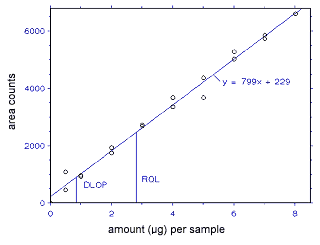
Figure 1.2.1. Plot of data to determine the DLOP/RQL.
1.2.2 Reliable quantitation limit (RQL)
The reliable quantitation limit is 2.8 µg per sample (0.02 ppm or 0.09 mg/m3). This is the amount of analyte spiked on a sampler that will give a signal that is considered the lower limit for precise quantitative measurements.
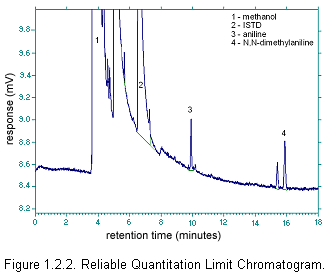 The RQL is considered the lower limit for
precise quantitative measurements. It is determined from in the
regression line data obtained for the calculation of the DLOP (Section
1.2.1), providing at least 75% of the analyte is recovered. The
RQL is defined as the concentration of analyte that gives a response
(YRQL) such that
The RQL is considered the lower limit for
precise quantitative measurements. It is determined from in the
regression line data obtained for the calculation of the DLOP (Section
1.2.1), providing at least 75% of the analyte is recovered. The
RQL is defined as the concentration of analyte that gives a response
(YRQL) such that
YRQL - YBR =
10(SDBR)
therefore
| RQL = | 10(SEE)
A |
2. Sampling Procedure
2.1 Apparatus
2.1.1 Samples are collected using a personal sampling pump calibrated, with the sampling device attached, to within ±5% of the recommended flow rate.
2.1.2 Samples are collected on 10% phosphoric acid coated
2.2 Technique
2.2.1 Immediately before sampling, break off the ends of the sampling tube. All tubes should be from the same lot.
2.2.2 Attach the sampling tube to the sampling pump with flexible tubing. It is desirable to utilize sampling tube holders which have a protective cover to shield the employee from the sharp, jagged end of the sampling tube. Position the tube so that sampled air passes through the sampling, larger, section of the tube first.
2.2.3 Air being sampled should not pass through any hose or tubing before entering the sampling tube.
2.2.4 Attach the sampler vertically with the sampling, larger, section downward, in the worker's breathing zone, and positioned so it does not impede work performance or safety.
2.2.5 After sampling for the appropriate time, remove the sample
and seal the tube with plastic end caps. Wrap each sample
2.2.6 Submit at least one blank sample with each set of samples. Handle the blank sampler in the same manner as the other samples except draw no air through it.
2.2.7 Record sample volumes (in liters of air) for each sample, along with any potential interferences.
2.2.8 Ship bulk samples in separate containers from the air samples.
2.3 Desorption efficiency
The desorption efficiencies (DE) of
|
| |||||||||||||||||||||||||||||||||||||||||
|
| |||||||||||||||||||||||||||||||||||||||||
2.4 Retention Efficiency
The acid coated XAD-7 tubes were spiked with 1503 µg (10 ppm or 50
mg/m3) of
|
| |||
| sample i.d. |
µg spiked |
µg recovered |
recovered (decimal) |
|
| |||
| R1 R2 R3 R4 R5 R6 |
1503 1503 1503 1503 1503 1503 |
1401 1387 1359 1353 1399 1382 |
.932 .923 .904 .900 .931 .919 |
|
| |||
2.5 Sample storage
The front sections of 12 acid coated
|
| |||||||
| Ambient Storage
|
Refrigerator Storage
| ||||||
| days | µg theory | µg found | recovery (decimal) |
days | µg theory | µg found | recovery (decimal) |
|
| |||||||
| 7 7 7 14 14 14 |
751 751 751 751 751 751 |
596 651 628 737 727 736 |
.793 .866 .836 .980 .967 .979 |
7 7 7 14 14 14 |
751 751 751 751 751 751 |
625 648 643 728 748 763 |
.832 .862 .856 .969 .995 1.015 |
|
| |||||||
2.6 Recommended air volume and sampling rate.
2.6.1 The recommended air volume is 30 L.
2.6.2 The recommended sampling rate is 0.2 L/min.
2.7 Interferences
2.7.1 It is not known if any compounds will interfere with the
collection of
2.7.2 Any suspected interferences should be reported to the laboratory.
2.8 Safety precautions (sampling)
2.8.1 Attach the sampling equipment to the worker in such a manner that it will not interfere with work performance or safety.
2.8.2 Follow all safety practices that apply to the work area being sampled.
2.8.3 Wear eye protection when breaking the ends of the glass sampling tubes.
3. Analytical Procedure
3.1 Apparatus
3.1.1 A gas chromatograph (GC) equipped with a flame ionization detector (FID). A Hewlett Packard (HP) model 5890 was used in this evaluation.
3.1.2 A GC column capable of separating the analyte and an
internal standard from any interferences. The column used in this
study was a 60 m
3.1.3 An electronic integrator or some suitable method of measuring peak areas. A Waters 860 data system was used in this evaluation.
3.1.4 Two milliliter vials with
3.1.5 A 10 µL syringe or other convenient size for standard preparation.
3.1.6 Pipets for dispensing the desorbing solution. A dispenser may be used.
3.1.7 Volumetric flasks - 5 mL and other convenient sizes for preparing standards.
3.2 Reagents
3.2.1 Purified GC grade nitrogen, hydrogen, and air.
3.2.2 N,N-Dimethylaniline, Reagent grade
3.2.3 Methanol, reagent grade.
3.2.4 1-Hexanol, reagent grade. This was used as an internal standard (ISTD).
3.2.5 Ammonium hydroxide, reagent grade.
3.2.6 Desorbing solution. The desorbing solvent was prepared by
adding
3.3 Standard preparation
3.3.1 Stock standards are prepared by diluting a known quantity
of
3.3.2 Dilutions of the stock standards with desorbing solution were made to obtain lower working range standards of 0.7 µg/mL to 1600 µg/mL.
3.4 Sample preparation
3.4.1 Sample tubes are opened and the front and back section of each tube are placed in separate 2 mL vials.
3.4.2 Each section is desorbed with 1 mL of the desorbing solution.
3.4.3 The vials are sealed immediately and allowed to desorb for 30 minutes on a mechanical shaker.
3.5 Analysis
3.5.1 Gas chromatograph conditions.
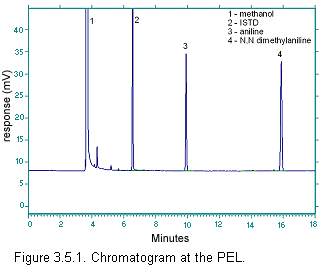
| Injection size: | 1 µL |
| Flow rates (mL/min) |
|
| Nitrogen (make-up): | 30 |
| Hydrogen(carrier): | 1.5 |
| Hydrogen(detector): | 60 |
| Air: 450 | |
| Temperatures (°C) | |
| Injector: | 200 |
| Detector: | 250 |
| Oven: | 120 |
| Retention times (min) | |
| ISTD | 6.9 |
| Aniline | 10.9 |
| N,N-Dimethylaniline | 18.1 |
3.5.2 Peak areas are measured with a data system or other suitable means.
3.6 Interferences (analytical)
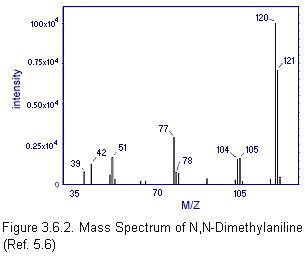 3.6.1 Any
compound that produces a response and has a similar retention time
as the analyte or internal standard is a potential interference. If
any potential interferences were reported, they should be considered
before samples are desorbed. Generally, chromatographic conditions
can be altered to separate an interference from the analyte.
3.6.1 Any
compound that produces a response and has a similar retention time
as the analyte or internal standard is a potential interference. If
any potential interferences were reported, they should be considered
before samples are desorbed. Generally, chromatographic conditions
can be altered to separate an interference from the analyte.
3.6.2 When necessary, the identity of an analyte peak may be confirmed by GC-Mass spectrometry or by another analytical procedure.
3.7 Calculations
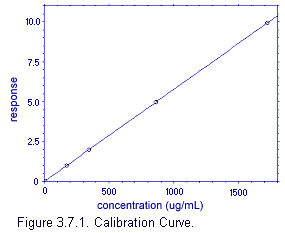 3.7.1
Construct a calibration curve by plotting detector response versus
concentration (µg/mL) of
3.7.1
Construct a calibration curve by plotting detector response versus
concentration (µg/mL) of
3.7.2 Determine the µg/mL of
3.7.3 Blank correct each sample by subtracting the µg/mL found in each section of the blank from the µg/mL found in the corresponding sections of the samples and then add the results together for the total µg/mL for each sample.
3.7.4 Determine the air concentration using the following formula.
| mg/m3 = | (µg/mL, blank corrected) × (desorption volume, mL)
(air volume, L) × (desorption efficiency, decimal) |
| ppm = | (mg/m3) × (24.46)
MW |
| where: | ||
| 24.46 | = | molar volume (liters/mole) at 101.3 kPa (760 mm Hg) and 25°C |
| MW | = | molecular weight (g/mole) of N,N-dimethylaniline |
3.8 Safety precautions
3.8.1 Adhere to the rules set down in your chemical hygiene plan when working with chemicals.
3.8.2 Avoid skin contact and inhalation of all chemicals.
3.8.3 Wear safety glasses, gloves and a lab coat at all times while in the laboratory areas.
4. Recommendations for Further Study
Collection studies need to be performed from a dynamically generated test atmosphere.
5. References
5.1 Eller, P. M., Ed.; NIOSH Manual of Analytical Methods,
3rd. ed; U.S. Department of Health and Human Services, Public Health
Service, Centers for Disease Control, National Institute for
Occupational Safety and Health, Division of Physical Sciences and
Engineering: Cincinnati, DHHS (NIOSH) Publication No.
5.2 Wood, G. and Anderson, R., Am. Ind. Hyg. Assoc. J, 1975, 36(7), 538-548.
5.3 Documentation of the Threshold Limit Values and Biological Exposure Indices, 5th. ed.; American Conference of Governmental Industrial Hygienists, Inc.: Cincinnati, 1986; p 207.
5.4 Budavari, S. ED.; Merck Index, 11th ed.; Merck: Rahway, NJ, 1989; p 510.
5.5 Registry of Toxic Effects of Chemical Substances
5.6 EPA/NIH Mass Spectral Data Base, Vol. 1, 1980, p 58.